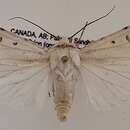Conservation Status
provided by University of Alberta Museums
An uncommon but widespread species; no concens.
- license
- cc-by-nc
- copyright
- University of Alberta Museums
Cyclicity
provided by University of Alberta Museums
Adults have been collected in Alberta during the last week of August and the first half of September
- license
- cc-by-nc
- copyright
- University of Alberta Museums
Distribution
provided by University of Alberta Museums
Southern Saskatchewan west to southern Vancouver Island, south to Kansas, New Mexico, Arizona and southern California. In Alberta catenula has been collected north to Calgary and Dinosaur Provincial Park.
- license
- cc-by-nc
- copyright
- University of Alberta Museums
General Description
provided by University of Alberta Museums
"A medium-size (3.4-3.7 cm wingspan) pale grey-white moth. The forewings are light chalky grey or tan, almost white, with a few scattered black scales. The transverse lines are reduced to a prominent black mark where each would meet the costa, with the postmedian line also indicated by a series of small spots or dashes at the veins. The orbicular spot is reduced to a few black scales or a small spot, and the reniniform is a prominent, black doubled spot. The terminal line is a series of small black triangles, and the fringe is light grey-white. The hindwings are bright white with a dark discal mark, sooty brown scales lining the veins, and a white fringe.
Pale specimens of E. spumata and E. tronella lack the prominent dark spots at the costa, and are light tan, not grey. Most likely to be mistaken for Agrotis vetusta, which is larger and lacks the dark scaling at the reniform spot. There are also excellent genital characters that will separate catenula from similar species. Catenula belongs to the subgenus Euxoa. Keys to the subgenera and species of Euxoa, along with illustrations of both sexes and their genitalia, are available in Lafontaine, 1987.
"
- license
- cc-by-nc
- copyright
- University of Alberta Museums
Habitat
provided by University of Alberta Museums
Arid shortgrass prairie, badlands and xeric open woodland.
- license
- cc-by-nc
- copyright
- University of Alberta Museums
Life Cycle
provided by University of Alberta Museums
There is a single brood each season, which emerges in late summer and overwinters in the egg stage. Adults are nocturnal and are attracted to light. The immature stages have not been described.
- license
- cc-by-nc
- copyright
- University of Alberta Museums
Trophic Strategy
provided by University of Alberta Museums
No Alberta data. Like most Euxoa, a general feeder on a variety of low plants. In Montana larvae have been collected on wheat (Tritium) , sweet clover (Meliotis), lupines (Lupinus), Russian thistle (Salsola), mustards (Cruciferae), violets (Viola), and milk-vetch (Astragalus).
- license
- cc-by-nc
- copyright
- University of Alberta Museums
Euxoa catenula: Brief Summary
provided by wikipedia EN
Euxoa catenula is a species of moth of the family Noctuidae first described by Augustus Radcliffe Grote in 1879. It is found in North America from southern Saskatchewan west to southern Vancouver Island, south to Kansas, New Mexico, Arizona and southern California.
The wingspan is 34–37 mm. Adults are on wing from August to September.
The larvae feed on Oxytropis, Melilotus alba, Lupinus, Salsola kali and Viola pedatifida.
- license
- cc-by-sa-3.0
- copyright
- Wikipedia authors and editors
Euxoa catenula: Brief Summary
(
Vietnamese
)
provided by wikipedia VI
Euxoa catenula là một loài bướm đêm thuộc họ Noctuidae. Nó được tìm thấy ở miền nam Saskatchewan phía tây đến miền nam đảo Vancouver, phía nam đến Kansas, New Mexico, Arizona và miền nam California.
Sải cánh dài 34–37 mm. Con trưởng thành bay từ tháng 8 đến tháng 9.
Ấu trùng ăn Oxytropis, Melilotus alba, Lupinus, Salsola kali và Viola pedatifida.
- license
- cc-by-sa-3.0
- copyright
- Wikipedia tác giả và biên tập viên


Phương tiện liên quan tới Euxoa catenula tại Wikimedia Commons